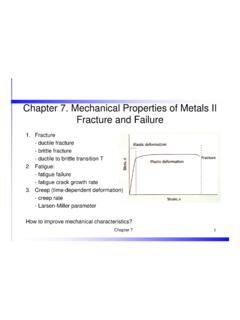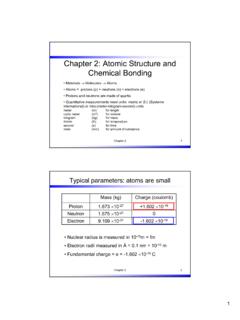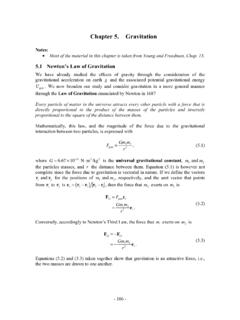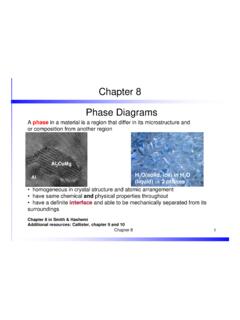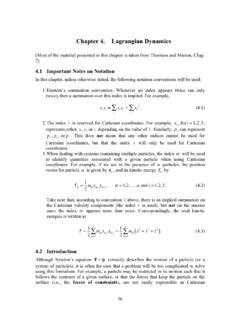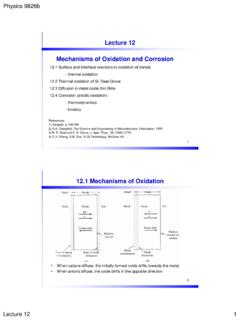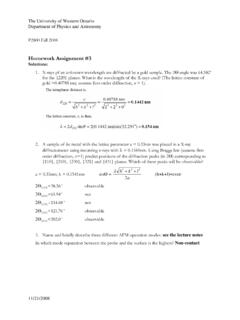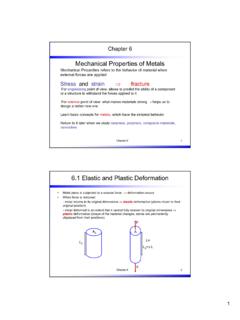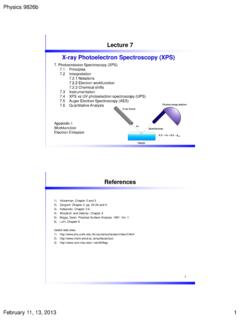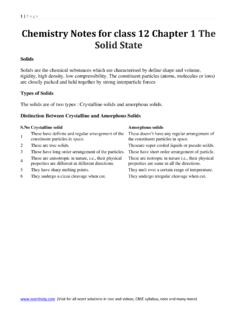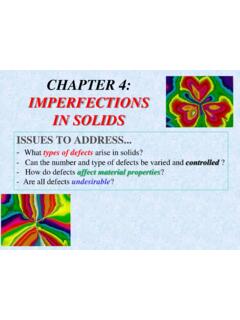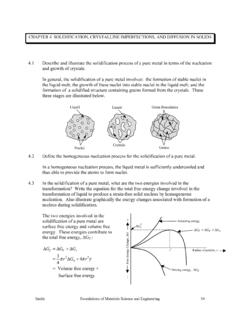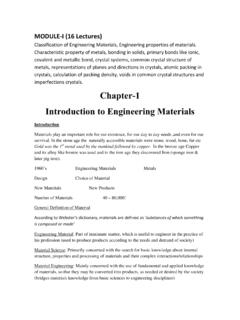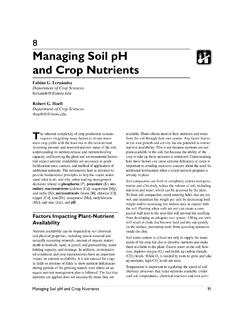Transcription of Chapter 5: Diffusion
1 1 Chapter 5 Chapter 5: DiffusionDiffusion: the movement of particles in a solid from an area of highconcentration to an area of lowconcentration, resulting in the uniform distribution of the substance Diffusionis process which is NOT due to the action of a force, but a result of the random movements of atoms (statistical problem)1. Diffusivity and 2 Fick s laws2. Atomistic mechanisms of diffusion3. Temperature dependence and Arrenius plot4. Industrial applications - carburized steel, - dopants in siliconChapter Steady-State Diffusion Recall:Solvent the majority atom type (or host atoms): Solute the element with lower concentrationSubstitutional a solid solution in which the solute atoms are replaced by soluteInterstitial solute atoms are located in gaps between host atomsConsider Diffusion of solute atoms (b) in solid state solution (AB) in direction x between two parallel atomic planes (separated by x) if there is no changes with timein CBat these planes such Diffusion condition is called steady-state diffusionFor a steady-state Diffusion , flux (flow),J,of atoms is.
2 DxdCDJ =J flux of atoms, atoms/(m2s): the number of particles which pass through a unit area in a unit of time;D diffusivity or Diffusion coefficient, m2/sdC/dx concentration gradient, atoms/m42 Chapter 5 Fick s first law of diffusionFor steady-state Diffusion condition (no change in the system with time), the net flow of atoms is equal to the diffusivity Dtimes the Diffusion gradient dC/dxdxdCDJ = = mmatomsdxdCsmDsmatomsJ1322 Diffusivity Ddepends on:1. Diffusion mechanism2. Temperature of diffusion3. Type of crystal structure (bcc > fcc)4. Crystal imperfections5. Concentration of diffusing species - sign: flux direction is from the higher to the lower concentration.
3 It is the opposite to the concentration gradientChapter 5 Non-Steady-State DiffusionIn practice the concentrationof solute atoms at any point in the material changes with time non-steady-state diffusionFor non-steady-state condition, Diffusion coefficient, D- NOT dependent on time: =dxdCDdxddtdCxxSecondFick s law of Diffusion :The rate of compositional change is equal to the diffusivity times the rate of the change of the concentration gradient22xCDdtdCx =If D D(x), in 1D case: + + =222222zCyCxCDdtdCxIn 3D case:Change in concentration in 2 semi-infinite rods of Cu and Ni caused by Diffusion , From G. Gottstein Physical Foundations of Material Science 3 Chapter 5 Non-Steady-State Diffusion (continued)With specific initial or boundary conditions this partial differential equations can be solved to give the concentration as function of spatial position and time c(x, y, z, t)Let us consider two rods with different concentrations c1and c2which are joined at x=0 and both are so long that mathematically they can be considered as infinitely longThe concentration profile at t = 0 is discontinuous at x = 0:x< 0, c= c1.
4 X< 0, c= c2We can obtain solution of:22xCDdtdCx =functionerror theasknown is ,2)( where212),(021212122 = + = = zDtxdezerfDtxerfccdeccctxc Dtxz2= Chapter 5 Gas Diffusion into a solidLet us consider the case of a gas A diffusing into a solid BGas ASolid Bx = 0 = DtxerfCCCCoSxs2CS surf. C of element in gas diffusing into the surfaceCo initial uniform concentration of element in solidx - distance from surfaceD diffusivity of diffusing solute elementt timeerf mathematical function called error function4 Chapter 5 Error functionCurve of the error function erf (z)for Dtxz2= Chapter 5Q:Consider the gas carburizing of a gear of 1018steel (C wt %) at 927 C.
5 Calculate the time necessary to increase the C content to wt % at mm below the surface of the gear. Assume the C content at the surface to be wt % and that the nominal C content of the steel gear before carburizing is wt %. D (C in iron) at 927 C = 10-11m2/s5 Chapter Atomistics of Solid State Diffusion Diffusion mechanisms:1. Vacancy(substitutional) Diffusion migration of atom in a lattice assisted by the presence of vacanciesEx.: self Diffusion of Cu atoms in Cu crystal2. Interstitialdiffusion movement of atoms from one interstitial site to another neighboring interstitial site without permanent displacement any of the atoms in the matrix crystal latticeEx.
6 : C Diffusion in BCC ironChapter 5 VacanciesThe simplest point defect is the vacancy (V) an atom site from which an atom is missingVacancies are always present; their number NVdepends on temperature (T)vacancykTEVVeNN =NV - # of vacanciesN- number of lattice sitesEV energy required to form a vacancyk Boltzmann constant k= 10-23J K-1; or 10-5eV K-1T absolute temperature6 Chapter 5 Vacancy (Substitutional) Diffusion MechanismSubstitutional (in homogeneous system - self- Diffusion , in heterogeneous system solid state solutions) Vacancies are always present at any T As T increases # of vacancies increases Diffusion rate increases Move atom A (from (1) to (2)) = move vacancy from (2) to (1).
7 ?higher Tmelt stronger bonding between atoms high activation energy to move VChapter 5 Kirkendall effect Marker at the Diffusion interface move slightly in the opposite direction to the most rapidly moving species vacancies can move!7 Chapter 5 Possible mechanisms of self- Diffusion and their activation energy1. Neighboring atoms exchange sites2. Ring mechanism3. Vacancy mechanism4. Direct interstitial mechanism5. Indirect interstitial mechanism2 eV1 eV1 eV64 eV48 eV-8 eV1 TotalFormationMigrationChapter 5 Anisotropy EffectsFrom Physical Foundations of Material Science 8 Chapter 5 Carbon Diffusion in FeJump frequency [s-1] of an atom is given by:kTGme = Usually 1013[s-1] vibrational frequency of the atomThere is a fundamental relationship between the jump frequency and the Diffusion coefficient Dwhich is independent of mechanism and crystal structure.
8 6622= =D the jump distance of the diffusing atom =1/ the time interval between two jumpsJ = JMN -JNM32413241 =ANAMCCJ242aD = Chapter 5 Carbon Diffusion in FeCan be derived from an atomistic considerations of the Diffusion processesJ = JMN -JNM242aD = 6622= =DC atoms are located on the octahedral interstitial sites (black circles)Only of possible jumps of C atoms lead to flux in +xOnly 2/3 of all C atoms can jump in x direction9 Chapter Effects of T on Diffusion in solids Diffusion rate in a system will increase with temperature:RTEoAeDD =D diffusivity, m2/sD0-proportionality constant, m2/s, independent of TEA activation energy for diffusing species, J/molR molar gas constant R= J mol-1 K-1.
9 Or mol-1K-1T absolute temperatureChapter 5 Activation energyA + B C + DA (initial state) A* (final state) only a fraction of the molecules or atoms in a system will havesufficient energy to reach E* A thermally active process is one which requires a definite amount of thermal energy to overcome an activation energy barrier and enter the reactive state 10 Chapter 5 Bolzmann s equationkTEEe *yProbabilit On the basis of statistical analysis, Bolzmann s results showed that the probability of finding a molecule or atom at an energy level E*> the average energy E of all the molecules or atoms in a system at a particular temperature T, K, was:where kB= 10-23J/(atom K) -Boltzmann s constant The fraction of atoms or molecules in a system having energies > E* at a given T (where E* is much greater than the average energy of any atom or molecule: kTEtotaleCNn* = Chapter 5 Arrhenius Rate EquationThe rate of many chemical reaction as a function of temperature as follows:RTEAeCreactionofRate =__C rate constant, independent of TEA activation energyR molar gas constant R= J mol-1K-1; or mol-1K-1T absolute temperature11 Chapter 5 Typical Arrhenius PlotIf we rewrite in natural log plot:RTEC rateA =lnlnarate=lnbC=lnTx1=xmby +=or in logarithmic log = Chapter 5Q.)
10 :The diffusivity of Ag atoms in solid silver metal is at 500oC and at 1000oC. Calculate the activation energy (J/mole) for the Diffusion of Ag in Ag in the T range 500 to Industrial applicationsSteel Hardening by Gas CarburizingIn the gas carburizing process for steel parts, the parts are placed in a furnace in contact with a gas rich in CO-CH4mixture at ~927 C. Fe + x CH4 FeCx(x = C), T = 927oC The C from the gas diffuses into the surface of the steel part and increases the C content of the outer surface region of the part. The higher C concentration at the surface makes the steel harder in this region A steel part can thus be produced with a hard outer layer and a tough low C steel inner core (important, for example, for many types of gears) Chapter 5 Dopants activationDopants can be incorporated into Si wafer to change their electrical conducting characteristicsB, P+AnnealingmaskIon implantation13 Chapter 5Q:If boron, B, is diffused into a thick slice of Si with no previous B in it at a temperature of 1100 C for 5 h, what is the depth below the surface at which the concentration is 1017atoms/cm3if the surface concentration is 1018atoms/cm3?
